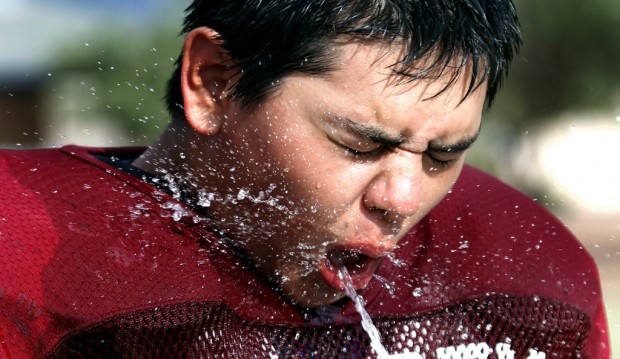
Ahletic trainers Pete Morales of Sahuarita High School and Johanna Urquijo of Walden Grove keep student-athletes healthy. They’re responsibilities range from simple first-aid to administering the IMPACT Test, a concussion baseline test that measures cognitive abilities. They’re also there to educate players about potential dangers on the field.
Morales, who started his 20th year at Sahuarita High this fall, said his main job is to be prepared for whatever happens during games.
“You’ve got to try and prepare for everything or anything that can happen, and ask yourself what can happen,” Morales said. “There’s a lot of nicks and knacks, and we’ll use gloves, ointments or various bandages to heal them.”
Urquijo, 24, was hired by Walden Grove to replace Chris Murphy in December. She graduated from Northern Arizona University with a degree in sports medicine last year and enjoys interacting with student-athletes.
“I took a sports medicine class and I fell in love with the field, and knew that’s what I wanted to do,” she said.
Urquijo was a student trainer during high school in Douglas, and is certified by the Arizona Board of Athletic Training, as is Morales.
Both schools bring in doctors for football games in case there are any serious injuries. Urquijo said having a doctor on the field helps ensure the safety of the players.
“It helps me out because I have an extra set of eyes out there,” she said. “It’s nice to get a second opinion to help decide if the player should be held out or if they can return to the game for sure.”
Morales, who has a master’s in physical education from the University of Nevada-Reno, wants to go a step further by bringing in additional medical personnel during games.
“It’d be nice to have a orthopedic surgeon out there to confirm things,” he said. “It’s just the peace of mind on my part, and that’d be nice.”
One tough job
Morales said he struggles with having to be the bearer of bad news when player’s are injured during a game.
“It’s always difficult telling the kid they can’t play because they have this or that going on,” he said. “Sometimes parents don’t want to hear that; sometimes coaches don’t want to hear that. But, fortunately, the coaches here listen to what I say and I’m just here to make sure the kids have the best possible experience they can.”
Most players who required hospitalization in the past were sent to University Medical Center in Tucson, though that’ll change now that Green Valley Hospital is open.
Morales said there’s still a growing issue revolving around how athletes respond to serious injuries during games.
“I show a couple of DVDs about how to hit to the kids and I came across a story of a young man who suffered a concussion and didn’t handle it properly,” he said. “I show that not so much to scare them but so they can be aware. It’s not worth biting the bullet and being the tough guy.”
ORIGINAL ARTICLE:
http://www.sahuaritasun.com/schools/helping-hand-athletic-trainers-on-the-sidelines-part-of-team/article_ff04b6ae-479f-11e5-bf40-e3816938290f.html